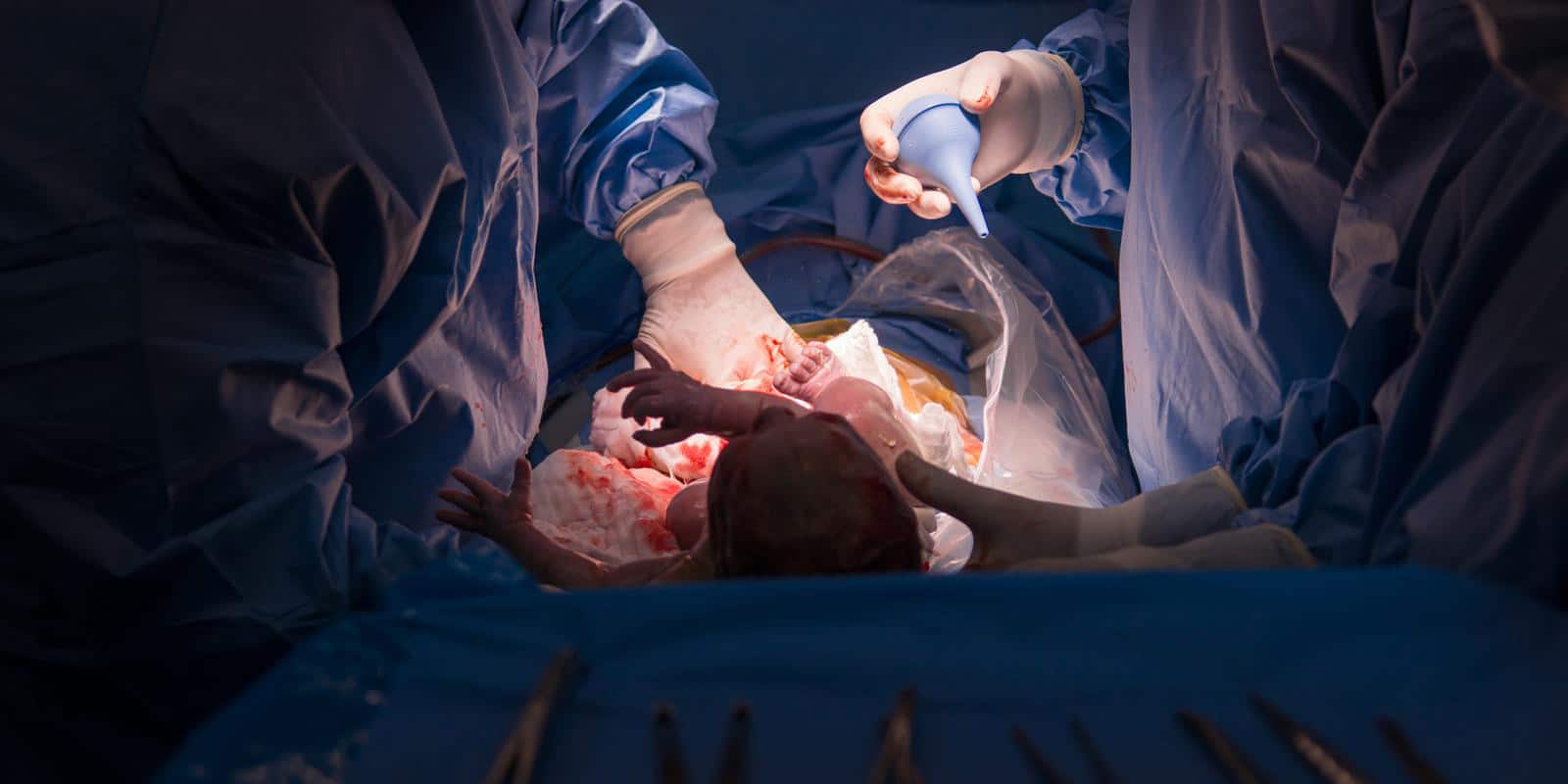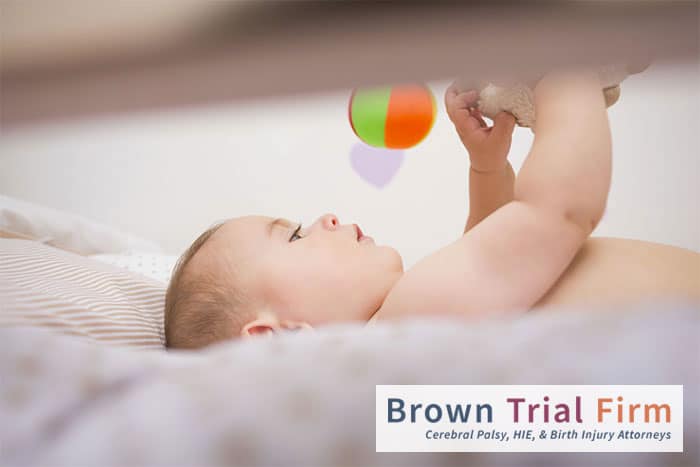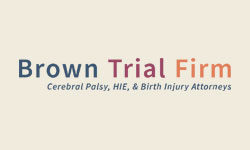Learn what’s normal and what signs indicate that your baby’s arching back could be the result of a birth injury
When it comes to understanding their babies, parents often feel like detectives—constantly looking for clues to interpret different cries, movements and behaviors. One such action that might catch your attention is when your baby arches their back while crying. For many parents, this can be a puzzling, if not unsettling, sight.
Is it a mere quirk, a part of normal baby behavior, or a sign of something more serious?
The good news is that babies cry to communicate a myriad of needs and feelings—from hunger and tiredness to discomfort and even just wanting some cuddle time. In most instances, a baby arching their back while crying is simply another form of this communication. It’s often a physical expression of frustration or discomfort or an attempt to get into a more comfortable position, and usually, it’s nothing to be overly concerned about.
However, in some rare instances, back-arching accompanied by other symptoms could signal a more serious issue, such as a birth injury, for which a medical evaluation could be warranted. In this article, we’ll delve into the nuances of why babies might arch their backs, when it’s typical behavior, and the rare circumstances under which it could be a cause for concern.
What does it mean when a baby arches their back?
Since babies can’t express themselves using words, they rely on physical movements and crying to convey their needs and feelings. In most instances, when a baby arches their back, it’s a completely normal behavior and not a cause for alarm.
Here are some common reasons why babies might arch their backs:
- They’re seeking comfort. Often, babies will arch their backs to find a more comfortable position, especially when they’re being held or lying down. This is often simply a matter of them trying to adjust and make themselves comfortable in their current position.
- They’re frustrated. Arched backs can be a sign of temporary frustration or anger. Babies have limited ways to express these emotions, so physical movements like arching their backs often come into play.
- They have indigestion or reflux. It’s not uncommon for babies to experience gastroesophageal reflux. Arching their backs can be a natural response to the discomfort they may feel. This usually resolves on its own or with minor interventions like changing feeding positions.
- They’re tired or overstimulated. Babies can get overwhelmed by their environments. An arched back may indicate that a baby is overtired or overstimulated and needs a break or a nap.
- They’re trying to roll over. As your baby grows and starts to explore more complex movements, they might arch their back as part of their attempts to roll over. This is usually a sign of normal development.
- They’re exhibiting a startle reflex. The startle reflex is a natural reaction that most babies have when they feel a loss of support or hear a loud noise. The baby may arch their back, extend their arms and legs, and then pull them back in. This is a typical infantile response that usually disappears by the age of 6 months.
- They have colic. Some babies who cry for prolonged periods may have colic, and they might arch their back during these episodes. While distressing to both the baby and their parents, colic is generally not harmful and often improves after a few months.
Depending on the cause, doctors may recommend different treatments to help babies with these issues. For example, craniosacral infant therapy might be suggested to help alleviate discomfort from gastroesophageal reflux or other tension-related problems. This gentle therapy can improve the baby’s overall comfort and well-being.
When should I be worried about my baby arching their back?
While a baby arching their back is often a completely normal behavior or response to specific temporary conditions like discomfort or frustration, there are instances when arching the back could be a sign of a more serious issue like a birth injury.
It’s essential to remember that such situations are relatively rare but should not be overlooked if observed in combination with other concerning symptoms.
Jaundice or kernicterus
If your baby is arching their back and also has a yellowish tint to their skin or eyes, it might be a sign of kernicterus, a severe form of jaundice that requires prompt medical treatment. Kernicterus occurs when high levels of bilirubin, a yellow substance that forms when red blood cells break down, accumulate in the baby’s blood and affect the nervous system. This can cause muscle rigidity and abnormal reflexes, which may result in a baby arching their back due to discomfort or pain.
If you notice that your baby is arching their back while also showing symptoms of severe jaundice—such as yellowing of the skin and eyes, lethargy or poor feeding—it’s crucial to seek immediate medical attention to prevent further complications.
Seizures
Seizures are sudden, uncontrolled electrical disturbances in the brain that can cause changes in behavior, movements and consciousness. Arching the back could be a part of a specific type of seizure known as “infantile spasms” or “West syndrome,” which usually occurs in the first year of life. During these seizures, a baby might briefly stiffen and arch their back, sometimes while crying.
If you observe your baby arching their back in combination with other unusual behaviors such as sudden, repetitive jerking movements, unresponsiveness, or prolonged crying episodes that seem different from their usual crying patterns, it may be cause for concern. Additionally, if these symptoms are accompanied by other signs like staring spells, rolling eyes or breathing difficulties, a neurological evaluation may be warranted.
Erb’s palsy
Erb’s palsy is a type of nerve damage that affects the brachial plexus, a network of nerves that control the muscles in the arm and shoulder. When these nerves are damaged during birth, it can lead to weakness, loss of motion, and even paralysis in the affected arm. A baby with Erb’s palsy might arch their back while crying as a way to compensate for the discomfort or inability to move the affected limb freely.
If you notice your baby frequently arching their back while crying, and they also show signs of arm weakness or lack of movement in one arm, be sure to mention it to your pediatrician. Timely diagnosis and treatment are essential for optimizing recovery and managing the symptoms of Erb’s palsy.
Cerebral palsy
Cerebral palsy is a group of disorders that affect movement, muscle tone and posture, often due to damage that occurs to the immature, developing brain, sometimes before birth or during labor and delivery. In the context of cerebral palsy, an arched back could be an indication of abnormal muscle tone or spasticity, a condition where muscles are continuously contracted.
Infants with cerebral palsy may have difficulty coordinating their muscles and might arch their back as a way to cope with muscle imbalances. They may also display other signs, such as delayed developmental milestones, difficulties in feeding, or an unusual posture, like favoring one side of the body.
It’s important to note that while an arched back could be one of the early indicators, it alone is not sufficient for a diagnosis of cerebral palsy. A comprehensive evaluation, including a detailed medical history and a series of tests and imaging studies, is essential for diagnosis. If parents are concerned about an arched back along with other symptoms, they should consult their pediatrician for a thorough evaluation.
Sandifer syndrome
Sandifer syndrome is a rare condition in children that is often associated with gastroesophageal reflux disease (GERD). It’s characterized by abnormal, spasmodic movements that can resemble seizures, such as arching the back, twisting the neck, and tilting the head. These movements are thought to help relieve the discomfort caused by acid reflux, and they often occur during or after feeding and may be accompanied by crying.
Because the symptoms of Sandifer syndrome can look similar to neurological issues or seizures, a proper diagnosis is crucial. This usually involves medical tests such as pH monitoring of the esophagus and sometimes an EEG to rule out seizures. If you observe frequent episodes of your baby arching their back while crying, particularly around feeding times, it’s advisable to consult their pediatrician for a thorough evaluation.
Autism
Autism spectrum disorder is a developmental condition characterized by repetitive behaviors and difficulties with social interaction and communication. While arching the back alone is not a diagnostic criterion for autism, it could potentially be one of several early indicators when observed with other symptoms.
If a baby has multiple other signs of developmental delays or behavioral concerns, such as not responding to their name by 12 months, not pointing at objects to show interest by 14 months, or not engaging in “pretend” games by 18 months, then it might warrant further evaluation.
Medical professionals rely on a comprehensive evaluation to diagnose autism, so if you have concerns about your child’s development, it’s crucial to consult with their pediatrician for a thorough assessment.
Learn about common types of birth injuries, symptoms, risk factors and treatments, as well as when you may be able to file a lawsuit for medical negligence.
When could a baby arching their back be a sign of a birth injury?
Why is my baby arching their back and screaming?
If your baby frequently arches their back while crying and also exhibiting other concerning symptoms, it might be an indication of a birth injury. The key is to watch for symptoms associated with specific conditions:
- Erb’s palsy. Weakness in one arm or a limited range of motion could indicate Erb’s palsy. This birth injury often happens when there is excessive pulling on the baby’s head and neck during delivery, particularly in situations like shoulder dystocia, where the baby’s head passes through the birth canal but the shoulders become stuck.
- Kernicterus. Severe jaundice, lethargy or other signs of extreme newborn jaundice could indicate kernicterus. Kernicterus usually arises from a medical oversight, such as failure to diagnose high bilirubin levels, failure to initiate appropriate treatment, or inadequate monitoring.
- Cerebral palsy. Muscle stiffness, tremors or difficulty with motor skills like grasping objects could indicate cerebral palsy. When cerebral palsy is the result of a birth injury, it’s usually due to complications that arise during labor and delivery that lead to oxygen deprivation, including delayed cesarean section (C-section) delivery and umbilical cord complications.
- Seizures. Episodes of spasms, shaking or brief loss of consciousness could indicate seizures. Seizures in a newborn can sometimes be the result of a birth injury, usually due to underlying brain damage or dysfunction that occurred during the labor and delivery process. The primary cause is often oxygen deprivation, which can happen for a variety of reasons, such as complications with the umbilical cord, prolonged labor, or delays in performing a C-section when necessary.
If your baby’s back-arching is accompanied by any of these symptoms, consult your child’s pediatrician for a comprehensive assessment and diagnosis. If you believe your child’s symptoms may be the result of a birth injury, contact an experienced birth injury attorney to discuss your legal options for holding the responsible party accountable and recovering compensation.
Did your baby suffer a birth injury or trauma? Certain types of developmental delays can be an early indicator.
FAQs
What is the syndrome associated with babies arching their backs?
The syndrome most often associated with a baby arching their back is known as Sandifer syndrome. This rare pediatric condition is often linked with gastroesophageal reflux disease.
Babies with Sandifer syndrome may display abnormal postures and movements, such as arching their backs, twisting their necks, or tilting their heads. These movements are thought to be the body’s way of coping with the discomfort caused by acid reflux.
Do babies with cerebral palsy arch their backs?
Babies with cerebral palsy may display a variety of motor issues and abnormal postures, which can sometimes include arching their backs. Cerebral palsy affects muscle tone and control, leading to either spasticity, where muscles are stiff and resist movement, or hypotonia, where muscles are too relaxed. In the case of spastic cerebral palsy, the baby may arch their back due to increased muscle tone.
However, it’s important to note that arching the back is a common behavior in many babies and is not solely indicative of cerebral palsy.
Do babies with autism arch their backs?
Symptoms of autism in infants can vary widely and may not become fully evident until a child is 2 years old or older. However, some early signs may start to appear in the first few months or years of life. While arching the back isn’t traditionally identified as a key symptom of autism, it could be part of a larger pattern of atypical behavior or physical responsiveness.
Here are some other symptoms commonly associated with autism in infants:
- Delayed or absent speech development (like babbling)
- Reduced or inconsistent eye contact
- Limited use of gestures such as waving or pointing
- Lack of engagement in interactions such as playing peek-a-boo
- Repetitive behaviors like flapping hands, rocking back and forth, or being overly fascinated with lights or moving objects
It’s essential to note that each child is different, and many children who display some symptoms of autism at a young age do not end up having the disorder. If you’re concerned about your child’s behavior or development, be sure to discuss your concerns with their pediatrician.
How can a birth injury attorney help if I suspect my baby’s arched back is a sign of a birth injury?
If you suspect that your baby’s arched back is a sign of a birth injury, a birth injury attorney can provide specialized legal guidance and support.
First, they can help you understand your rights and evaluate your child’s medical records, consulting with medical experts to determine if there was negligence or malpractice involved. This could involve reviewing prenatal care, the circumstances of the delivery, and any postnatal care your baby received.
Second, they can help you determine if there is a viable legal claim and what damages you might be entitled to, such as medical expenses, long-term care costs, pain and suffering, and more.
Finally, an attorney can manage all legal aspects of the case, from gathering evidence to representing you in court if necessary. Their expertise ensures that you can navigate the complex legal landscape, allowing you to focus on your child’s well-being while pursuing justice and compensation for any injuries suffered.
Contact an experienced birth injury attorney
If you believe your child may have suffered an injury before, during or shortly after birth because of a medical professional’s negligence, contact the experienced birth injury attorneys at Brown Trial Firm.
Laura Brown and her team can evaluate your case and fight to get your child the compensation they need and deserve to live their life to the fullest. Time limits for filing a birth injury lawsuit vary by state, so be sure to start exploring your legal options before you miss your window to file a claim.
Contact Brown Trial Firm today for a free consultation to learn more.
- Cerebral Palsy
- Caput Succedaneum and Cephalohematoma
- Neonatal Intracranial Hemorrhage (Childbirth Brain Bleeds)
- Hydrocephalus (Extra Fluid in the Brain Cavity)
- Cervical Dystonia
- Hemiplegia (Brain or Spinal Cord Injury)
- Hemorrhagic Stroke
- Neonatal Stroke
- HIE
- Periventricular Leukomalacia (PVL) Brain Injury
- Infant Seizures
- Spastic Diplegia (Spasticity in the Legs)
- Top Risks for Birth Injuries
- Fetal Alcohol Syndrome
- Facial Paralysis
- Spinal Cord Injuries
- Bell’s Palsy
- Brachial Plexus Nerves & Erb’s Palsy
- Klumpke’s Palsy
- G-Tubes for Newborns
- Medical Errors
- Cesarean Section & Birth Injury
- Negligence in Brain Cooling Treatment
- Craniosacral Therapy
- Occupational Therapy
- Speech Therapy
- Transition From Pediatric to Adult Healthcare
- Surgical Options for Spastic Cerebral Palsy
- Fetal Intolerance to Labor
- Jaundice (Kernicterus)
- Breech Position
- Placental Complications
- Umbilical Cord Problems
- Uterine Rupture
- Cervical Incompetence (Insufficiency)
- Blighted Ovum
- Necrotizing Enterocolitis (NEC) - Intestinal Inflammation
- Cephalopelvic Disproportion
- Meconium Aspiration Syndrome
- Amniotic Fluid Embolism
- Birth Injury from Premature Delivery
- Developmental Delays
- Abnormal Cord Insertion
- Infections at Birth
- Chorioamnionitis Bacterial Infection
- Premature birth
- Oxygen Deprivation
- Listeria
- Birth-Acquired Herpes
- Placenta Previa
- Placental Abruption
- Mismanaged Fetal Malposition
- Rapid Labor
- Obesity Related Birth Injuries
- Intrauterine Growth Restriction
- Blood Clots During Pregnancy
- Ectopic Pregnancy Misdiagnosis
- Myths & Facts About Birth Injuries
- Bacterial Vaginosis
- Gestational Diabetes
- Maternal Mortality Risk
- Oligohydramnios (Low Amniotic Fluid)
- Infections During Pregnancy
- Excessive Bleeding During Pregnancy
- Congenital Syphilis




